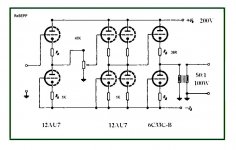Stee said:ciao🙂
my idea is Reverse standard Single Ended Push Pull
just to have input and output in ground level
and put a low ratio transformer on big power tube
😉
Definitely not a SEPP at all. There's no phase splitter, so all you have is a cathode follower with an active triode load. I have my doubts as to how that's going to work as is. Might be better to use a White cathode follower since that restores active pull up/pull down.
The A Number One problem with all SEPP-like designs is that they are balanced for one specific load impedance. Let the load change (and speeks are anything but a constant load) and it goes out of balance with rising distortion.
TOTAL SEPP DESIGN
Hi
SEPP configuration don't need splitter (there is a virtual active load)
is like OTL configuration (Camorani's design)
http://www.audiodesignguide.com/otl/otl_s_page3.tif
normally used for preamplifier
in this case with transformer
http://www.icl.co.jp/audio/english/k-mt.htm
the load change
and also the local feedback
see this:
http://www.audiophonics.com/audiophonics-zeus-line-driver-6c33c-pp-1.html
Best Regards
Hi
SEPP configuration don't need splitter (there is a virtual active load)
is like OTL configuration (Camorani's design)
http://www.audiodesignguide.com/otl/otl_s_page3.tif
normally used for preamplifier
in this case with transformer
http://www.icl.co.jp/audio/english/k-mt.htm
the load change
and also the local feedback
see this:
http://www.audiophonics.com/audiophonics-zeus-line-driver-6c33c-pp-1.html
Best Regards
Your schematic doesn't show a SEPP, it show a cathode follower output stage with active load.
A SEPP is unbalanced, the upper part is a cathode follower and the lower part is a normal cathode grounded amplifier. The SEPPs that have been made commercial, (like Philips with EL86) give a lot of 2nd order distortion, ~10%
The Camoroni document is full of unsubstantiated claims about output power etc. A SEPP without phase splitter can only work in class A meaning that the output will be very low.
http://www.audiophonics.com/audioph...6c33c-pp-1.html
There is nothing about SEPPs in this link.
Best Regards Hans
A SEPP is unbalanced, the upper part is a cathode follower and the lower part is a normal cathode grounded amplifier. The SEPPs that have been made commercial, (like Philips with EL86) give a lot of 2nd order distortion, ~10%
The Camoroni document is full of unsubstantiated claims about output power etc. A SEPP without phase splitter can only work in class A meaning that the output will be very low.
http://www.audiophonics.com/audioph...6c33c-pp-1.html
There is nothing about SEPPs in this link.
Best Regards Hans
there is a topology called PPP (push pull parallel) - just don't happen to have a schematic around. In this, two cathode followers are driving an output transformer. I built it and it sounds pretty good actually.
will try to find a schematic and post....
will try to find a schematic and post....
PPP Design
Thanks for your reply
may be the discussion is about name of architecture, i'm wrong
i would like to focus quality of sound
not the power or rendering
my idea is concentrated on benefits in pure complementary configuration, especially in class A, like this drawing
the link of Susan Parker show how is good have load on cathode
in particular to have local NFB (she named this "zero feedback")
Thanks for your reply
may be the discussion is about name of architecture, i'm wrong
i would like to focus quality of sound
not the power or rendering
my idea is concentrated on benefits in pure complementary configuration, especially in class A, like this drawing
the link of Susan Parker show how is good have load on cathode
in particular to have local NFB (she named this "zero feedback")
What you have drawn is just series connected cathode followers which means that the total gain from input to the output cathode will be less than 1. Maybe you intended to draw series connected SEPP or SRPP stages, the difference is then that the input is the lower grid and the output is the upper cathode on each stage.
However A SEPP doesn't work as if it would be a complimentary configuration even if if it look like that, the SEPP is inherently unbalanced as has been described before, (the gain of the lower and upper tube are different). The way to provide a complimentary function where both the upper and lower tubes provide same gain is to introduce drive to both tubes and a gain compensation method whereof the Futterman connection is the most well known although there are several others.
How Susan Parker can call a cathode coupled stage, (that have infinite feedback) as zero feedback is interesting in itself but it is of course nothing new to use a cathode follower output stage.
Regards Hans
However A SEPP doesn't work as if it would be a complimentary configuration even if if it look like that, the SEPP is inherently unbalanced as has been described before, (the gain of the lower and upper tube are different). The way to provide a complimentary function where both the upper and lower tubes provide same gain is to introduce drive to both tubes and a gain compensation method whereof the Futterman connection is the most well known although there are several others.
How Susan Parker can call a cathode coupled stage, (that have infinite feedback) as zero feedback is interesting in itself but it is of course nothing new to use a cathode follower output stage.
Regards Hans
- Status
- Not open for further replies.
- Home
- Amplifiers
- Tubes / Valves
- ReSEPP Design: 5 Tubes 4 Natural Sound
